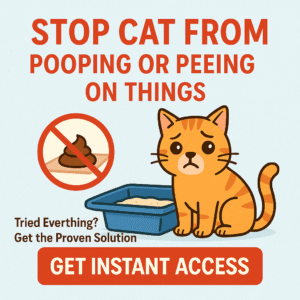When your cat starts peeing on kitchen counters, it’s more than annoying—it’s a message. This guide uncovers WHY it happens, shows step-by-step solutions, and helps restore harmony to your kitchen and your cat’s routine.
The Cat Spray No More ebook provides the tracking tools, behavior plans, and environmental strategies you’ll need to make positive change stick—fast.
Why Are They Using the Counter?
Quick answer: Cats pee on counters when they’re seeking height, hiding spaces, or they’re marking due to stress or box problems. It’s not spite—it’s stress, medical signals, or confusion about boundaries.
1. Health Check: Always Rule Out Medical Causes
- UTIs, bladder crystals or stones, kidney disease, diabetes—any can trigger location-based avoidance.
- Arthritis or mobility issues can make jumping in and out of the litter box painful.
- Action step: Visit the vet for urinalysis and bloodwork to rule out issues. Treatment often stops the inappropriate peeing.
2. Is It Marking or Avoidance?
| Marking (Spray) | Avoidance |
|---|---|
| Small amount, usually vertical surface edge | Larger puddle on horizontal counter surface |
| Tail-up posture | Tail-down, relaxed posture |
| Often around stress triggers (new pet, visitor) | Could occur when box is blocked or unclean |
Identifying which helps shape the solution: marking requires territorial fixes; accidents need box and comfort strategies.
3. Litter Box Setup – Fix What’s Under Their Feet
- One box per cat, plus one extra—spread them around, especially on the same level as the counter.
- Scoop at least once daily; deep clean weekly.
- Use large, open boxes with fine, unscented clumping litter.
- Avoid placing boxes near the kitchen or noisy appliances—privacy matters.
Give your cat easy, calm access to litter before they think the counter is a better option.
4. Stress & Environmental Triggers
- New pets, visitors, changes in routine, or door traffic can push cats to reassert control.
- Outdoor cats visible through windows often trigger marking inside.
- Pheromone diffusers like Feliway near counters can help soothe anxiety.
- Provide vertical perches and hideaways near the kitchen to give them safe vantage points.
5. Deep Clean & Break the Smell Pathway
- Use an enzyme-based cleaner on the counter and surrounding surfaces.
- Let it sit for 10–15 minutes thoroughly.
- Rinse and air-dry completely before removing residue.
- Place a temporary barrier, like aluminum or plastic, until your cat relearns boundaries.
6. Redirect & Positive Reinforcement
- Catch your cat approaching the counter—gently redirect to the litter box.
- When they use the box, immediately reward with praise or treats.
- Maintain calm, avoid punishment—it increases anxiety and risk of relapse.
7. Build a Cat-Friendly Kitchen Zone
- Install cat shelves or walkway close to but not on the counter.
- Offer enrichment like puzzle feeders and play toys elsewhere.
- Block direct counter access when unsupervised.
8. Logging, Routine & Structure
The Cat Spray No More ebook equips you with systems to:
- Log incidents—what time, which counter, any triggers.
- Schedule cleaning and litter care for consistency.
- Plan feeding, play, and bathroom checks as part of daily routine.
9. When to Consult a Behaviorist
- Peeping persists beyond 14–21 days despite efforts.
- Medical treatment didn’t resolve avoidance.
- Accidents become habitual across locations.
- Multi-cat tensions or anxiety seem chronic.
Certified animal behaviorists and veterinary behaviorists can help with tailored plans.
10. Success Story
“Oliver began peeing on the kitchen counter after we switched appliances. We deep-cleaned with enzyme spray, installed kitty shelves below kitchen window, added a Feliway diffuser, and set a second open litter box nearby. We followed the ebook’s logs and reward plan. Within two weeks, the counter was accident-free, and he now watches from his shelf when we cook.”
11. 14-Day “Kitchen Counter Rescue” Plan
| Days | Focus | Actions |
|---|---|---|
| 1–2 | Medical & Clean | Vet check, deep-clean counter, block access |
| 3–5 | Box Setup | Add box near kitchen, clean daily, use new litter |
| 6–9 | Stress Relief | Install pheromone diffuser, add shelves and hiding spots |
| 10–14 | Redirect & Reward | Catch counter attempts, guide to box, praise successes, log events |
| 15+ | Maintain & Monitor | Weekly logs, deep clean monthly, seek help if needed |
12. What Success Looks Like
- Week 1: Noticeable decline in counter peeing.
- Week 2–4: Consistent litter box use replaces counter behavior.
- 1–2 months: Routine habits solidified, kitchen stays clean.
- 3+ months: No relapses, confident cat, peaceful home.
Conclusion: Turn Counters Into Calm with Compassion & Structure
Peeing on kitchen counters isn’t spite—it’s your cat signaling stress, discomfort, or confusion. By combining veterinary care, comfortable litter setup, calm environment, enrichment, tracking, and positive reinforcement—with guidance from Cat Spray No More—you can guide your cat away from counters and toward confidence.
Download Cat Spray No More now and reclaim your kitchen—and your cat’s peace of mind—with clarity, control, and calm.
